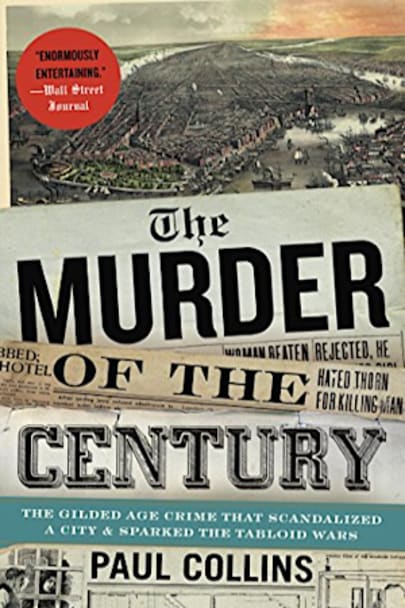“No writer better articulates ourinterest in the confluence of hope, eccentricity, and the timelessness of the bold and strange than Paul Collins.”—Dave Eggers On Long Island, a farmer finds a duck pond turned red with blood. On the Lower East Side, two boys playing at a pier discover a floating human torso wrapped tightly in oilcloth. Blueberry pickers near Harlem stumble upon neatly severed … neatly severed limbs in an overgrown ditch. Clues to a horrifying crime are turning up all over New York, but the police are baffled: There are no witnesses, no motives, no suspects.
The grisly finds that began on the afternoon of June 26, 1897, plunged detectives
headlong into the era’s most baffling murder mystery. Seized upon by battling media moguls Joseph Pulitzer and William Randolph Hearst, the case became a publicity circus. Reenactments of the murder were staged in Times Square, armed reporters lurked in the streets of Hell’s Kitchen in pursuit of suspects, and an unlikely trio—a hard-luck cop, a cub reporter, and an eccentric professor—all raced to solve the crime.
What emerged was a sensational love triangle and an even more sensational trial: an unprecedented capital case hinging on circumstantial evidence around a victim whom the police couldn’t identify with certainty, and who the defense claimed wasn’t even dead. The Murder of the Century is a rollicking tale—a rich evocation of America during the Gilded Age and a colorful re-creation of the tabloid wars that have dominated media to this day.
more



The term “yellow journalism” was coined during the period of this murder and its trial, which became a complete circus and was the forerunner to the tabloid journalism coverage of sensational, usually gory, crimes. Starting with the discovery in New York of body parts in June 1897 and running through the investigation and two trials, the Hearst and Pulitzer newspapers (as well as the NYT and other outlets) not only covered the Crime of the Century but made their own news – pushing into the case in a way that today would be considered obstruction of justice but at the time was so unprecedented, no one knew how to handle it. A fascinating story very relevant to today, and well-written. Recommended, certainly!
Fascinating story of murder in German immigrant community in New York.
This book was very well written and interesting. I highly recommend it for people who like true crime.
An excellent look at the heyday of Yellow Journalism and the nascent metro New York PD. Pulitzer and Hearst come to vivid life in this well told tale that is truly just one of many ‘crimes of the century’ in the early 20th when folks were still rather easily shocked by the depravity in their midst.
I found Collins to recreate a truthful rendering of old NY and it’s milieu. He never gets in the way of the story while exposing Hearst and Pulitzer for the hucksters they were.
Paul Collins’s Murder of the Century offers readers a glimpse into big city crime when fingerprints were considered unreliable, DNA testing did not exist, cops and coroners were in somebody’s pocket, and journalists were as likely to solve a murder as law enforcement.
So what is the so-called murder of the century? Amid a broiling mid-summer heat wave in 1897, body parts begin turning up across New York City – a torso in the East River, limbs in Harlem, that kind of thing. But whose are they? And where is the head? And, most importantly, who is responsible? While one cop works doggedly to answer these questions, William Randolph Hearst and Joseph Pulitzer use the crime as an opportunity to turn up the heat in their tabloid war with one another.
The Murder of the Century is as much a tale of yellow journalism as it is of murder. In many ways, I was reminded of the murder which captivated London just a few years later, that committed by Hawley Harvey Crippen and detailed by Erik Larson in Thunderstruck. Collins does a good job with both the journalism and the murder, but I couldn’t help feeling that there just wasn’t quite enough material here for a full book. As a result, the book alternates between being highly readable and completely bogged down in details that feel extraneous to the story he’s telling.
(This review was originally published at https://www.thisyearinbooks.com/2015/07/the-murder-of-century-gilded-age-crime.html)
I love any history stories This shows how things were back in the 1900s.
Have the background on not only a murder in NYC and the aftermath but also the background of how major newspapers fought for headlines back in that era.
Couldn’t finish it